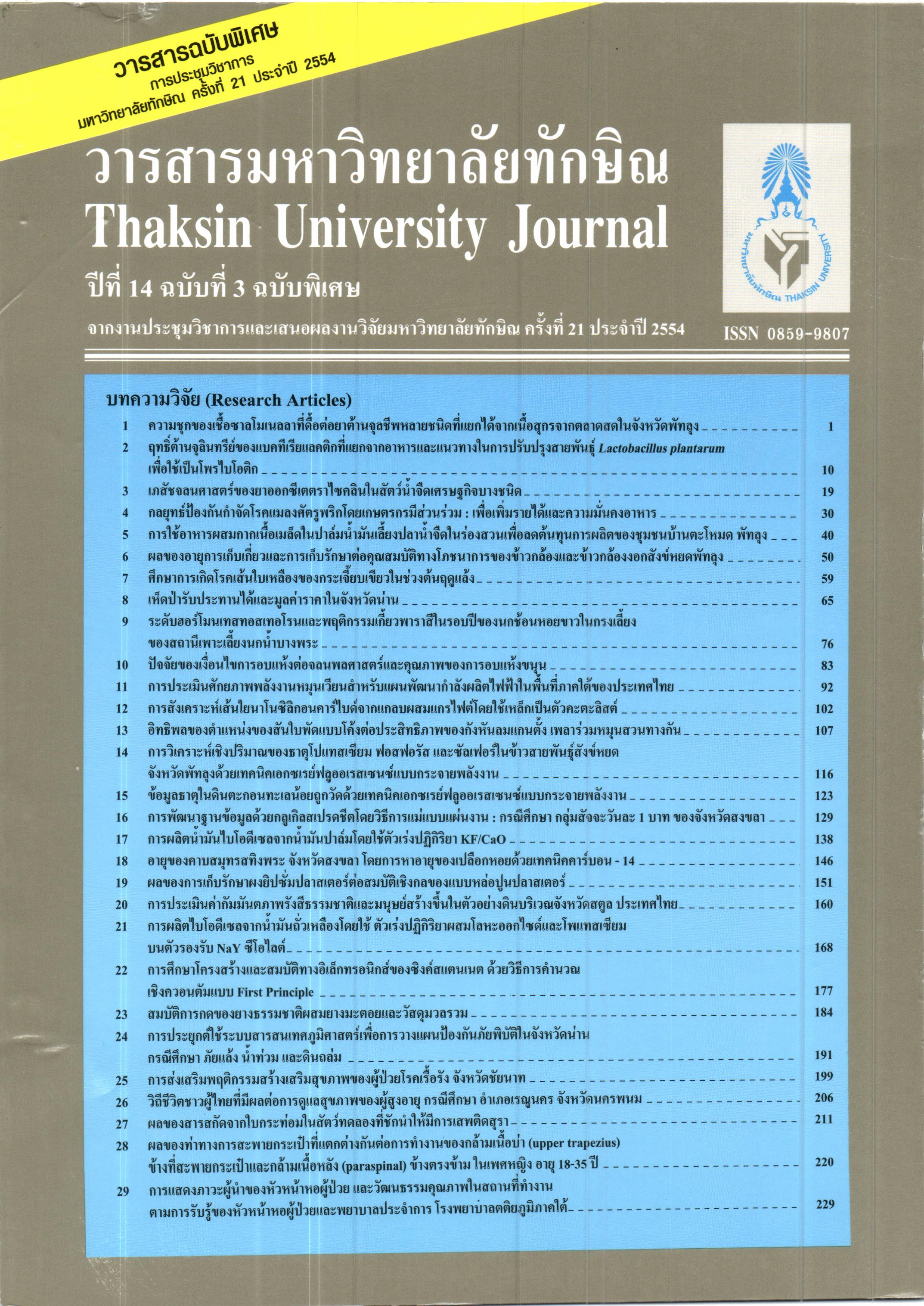การประเมินค่ากัมมันตภาพรังสีธรรมชาติและมนุษย์สร้างขึ้นในตัวอย่างดินบริเวณ จังหวัดสตูล ประเทศไทย
Main Article Content
Abstract
ได้ทำการตรวจวัดและวิเคราะห์ค่ากัมมันตภาพจำเพาะของนิวไคลด์กัมมันตรังสีเริ่มต้นที่มีในธรรมชาติ (40K, 226Ra และ232Th) และนิวไคลด์กัมมันตรังสีที่มนุษย์สร้างขึ้น (137Cs) ในตัวอย่างดินจำนวน 135 ตัวอย่าง ที่เก็บจากอำเภอเมือง อำเภอควนโดน อำเภอควนกาหลง อำเภอท่าแพ อำเภอละงู อำเภอทุ่งหว้า และอำเภอมะนังของ จังหวัดสตูลทางภาคใต้ของประเทศไทย โดยใช้หัววัดรังสีแบบเจอร์มาเนียมบริสุทธิ์และระบบวิเคราะห์แบบแกมมาสเ ปกโตรเมตรี ณ ห้องปฏิบัติการฟิสิกส์นิวเคลียร์และฟิสิกส์วัสดุ สาขาวิชาฟิสิกส์ คณะวิทยาศาสตร์ มหาวิทยาลัยทักษิณ วิทยาเขตสงขลา โดยใช้เวลาในการตรวจวัดตัวอย่างละ 10,800 วินาที จากผลการทดลอง พบว่า ค่ากัมมันตภาพจำเพาะ เฉลี่ยของนิวไคลด์ 40K, 232Th, 226Ra และ 137Cs มีค่าพิสัยอยู่ในช่วง 0.00 – 17,179.11 Bq/kg, 0.00 – 216.15 Bq/kg, 0.00 – 450.83 Bq/kg, และ 0.00 - 16.28 Bq/kg และมีค่าเฉลี่ย 4,020.90 ± 246.55 Bq/kg, 63.63 ± 2.34 Bq/kg, 98.75 ± 6.76 Bq/kg, และ 0.64 ± 0.21Bq/kg ตามลำดับ นอกจากนี้ได้ใช้ข้อมูลที่ได้จากการตรวจวัดและวิเคราะห์ค่ากัมมันตภาพ จำเพาะของนิวไคลด์กัมมันตรังสีเริ่มต้นที่มีในธรรมชาติในตัวอย่างดินที่เก็บจากทั้ง 7 อำเภอ ในบริเวณจังหวัดสตูลนี้ มาคำนวณค่าดัชนีที่บ่งชี้ถึงความเป็นอันตรายต่างๆ ของผู้คนที่อาศัยอยู่ในพื้นที่ดังกล่าวนี้ คือค่าอัตราปริมาณ รังสีแกมมา ดูดกลืน ค่ากัมมันตภาพรังสีสมมูลของเรเดียม (Raeq) ค่าดัชนีวัดความเสี่ยงรังสีที่ได้รับภายนอก ร่างกาย (Hex) และค่าปริมาณรังสียังผลที่ได้รับภายนอกร่างกายประจำปี (AEDout) และยังได้เปรียบเทียบ ค่าตรวจวัดและคำนวณได้ในการทำวิจัยครั้งนี้กับค่าที่ตรวจวัดได้ของสำนักงานปรมาณูเพื่อสันติและข้อมูล ของกลุ่มนักวิจัยในต่างประเทศทั่วโลก และยังนำข้อมูลที่ได้นี้ไปเปรียบเทียบกับค่าที่กำหนดไว้โดยองค์การ สหประชาชาติเกี่ยวกับผลของรังสีปรมาณู (United Nations Scientific Committee on the Effects of Atomic Radiation: UNSCEAR, 1988,1993,2000) อีกด้วย
Specific activities of natural (40K, 232Th and 226Ra) and artificial anthropogenic (137Cs) radionuclides in 135 soil samples collected from Muang, Khuan Don, Khuan Kalong, Tha Phae, Langu, Thung Wa and Manang Districts in Satun province have been measured and analyzed. Experimental results were obtained by using a high-purity germanium (HPGe) detector and gamma spectrometry analysis system. Experimental set-up and measurements were operated and carried out at Nuclear and Material Physics Laboratory in Department of Physics, Faculty of Science, Thaksin University, Songkhla Campus. The measuring time of each sample is 10,800 seconds. It was found that, the soil specific activity ranges from 0.00 – 17,179.11 Bq/ kg for 40K, 0.00 – 216.15 Bq/kg for 232Th, 0.00 – 450.83 Bq/kg for 226Ra and 0.00 - 16.28 Bq/kg for 137Cs with mean values of 4,020.90 ± 246.55 Bq/kg, 63.63 ± 2.34 Bq/kg, 98.75 ± 6.76 Bq/kg, and 0.64 ± 0.21Bq/ kg, respectively. Furthermore, the results were also used to evaluate the absorbed dose rates in air (D), the radium equivalent (Raeq), the external hazard index (Hex) and the annual effective dose rate (AEDout) for this area. Moreover, experimental results were also compared to the Office of Atoms for Peace (OAP) research data, Thailand and global radioactivity measurements and evaluation, the recommended values which were proposed by the United Nations Scientific Committee on the Effects of Atomic Radiation (UNSCEAR, 1988, 1993, 2000).


